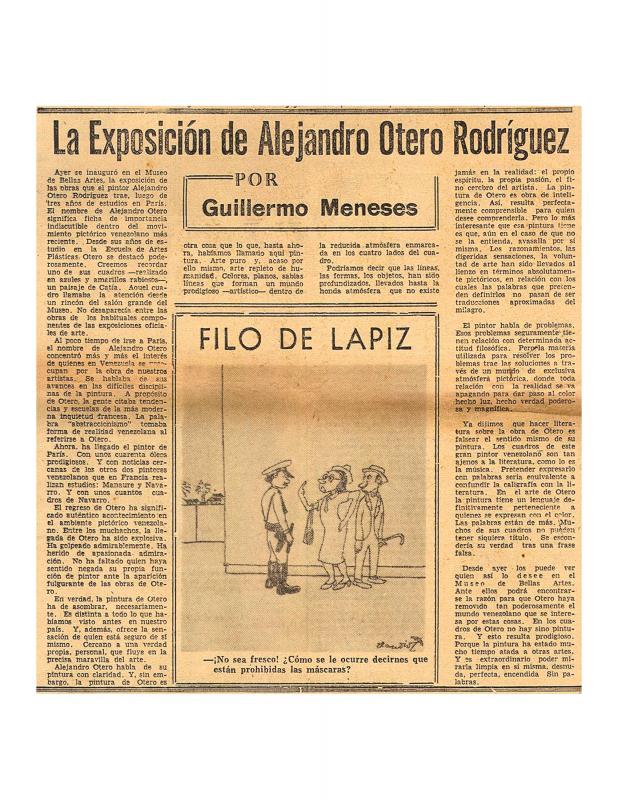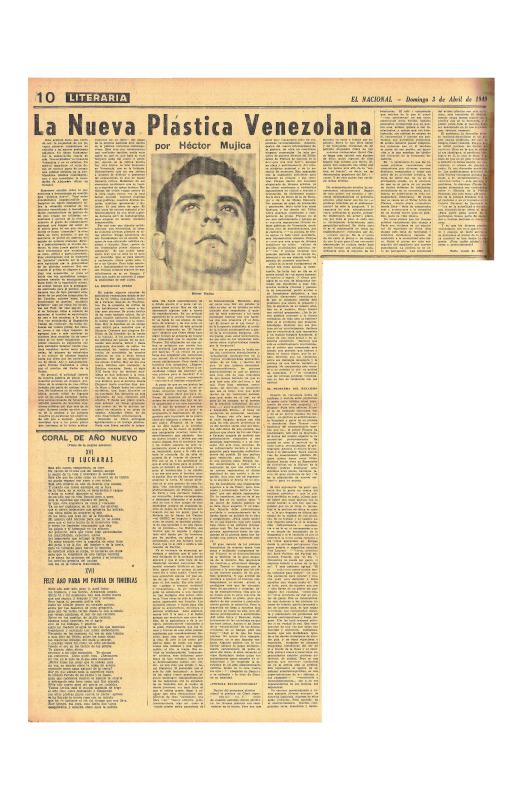Alejandro Otero (1921–90), the noted Venezuelan painter and sculptor, played a key role in the introduction of geometrical abstraction in Venezuela; he also did important theoretical and teaching work, communicating the axiological underpinnings of the development and implementation of his aesthetic values. In his essay, Juan Calzadilla (b. 1931) discusses this aspect of Otero’s career and, specifically, his pedagogical activities. A significant facet of this document is its recognition of Antonio Edmundo Monsanto, director of the EAPA (Escuela de Artes Plásticas y Aplicadas) and his method for promoting an axiological understanding of modern art among Otero’s generation. This helps to understand why many other compatriots living in Paris (other than Otero) embraced Abstraction in defense of the avant-garde and challenged the post-Impressionism of the EAPA in Caracas. The author also provides information about Otero’s efforts to take education beyond the classroom, using different means of communication (debates in the media, courses, magazines, theoretical articles, and lectures). His all-inclusive approach is testament to his commitment to involve art in all aspects of life. Finally, Calzadilla refers to the valuable resource that Otero designed: the lessons in the Curso de Apreciación Artística (1957). The essayist discusses the possibilities for expanding modern art and notes that the course material reflects Otero’s artistic concerns in terms of theory and expressive resources. In a way, his teaching of modern art laid the groundwork for his later work and the projects he developed for public spaces.
[For other critical articles about Otero’s work, see in the ICAA digital archive by J. R. Guillent Pérez (another member of the Los Disidentes group) “Realidad e irrealidad. El postigo de Alejandro Otero” (doc. no. 1172158); the essay by Guillermo Meneses “La exposición de Alejandro Otero Rodríguez” (doc. no. 1097092); by Roberto Guevara “La vertical vibrante de Maracay, 1968” (doc. no. 1168201); the essay by François Sego from the catalogue for the exhibition Alejandro Otero (1949) (doc. no. 850732); the essay by the journalist Héctor Mujica “La nueva plástica venezolana” (doc. no. 850512); the articles by María Elena Ramos “Alejandro Otero, permaneciendo. Retrospectiva en el Museo de Arte Contemporáneo” (doc. no. 1172282) and “Alejandro Otero: indagar en las estructuras de la realidad” (doc. no. 1167733); the review by Ernesto Guevara “Sólo quisiera ser puntual. El tiempo en la pintura de Alejandro Otero” (doc. no. 1163813); the essay by Damián Bayón “El espacio dinámico en la obra de Alejandro Otero” (doc. no. 1167828); Calzadilla’s other essay about his work “Exposiciones en Caracas: Alejandro Otero - Galería Mendoza” (doc. no 1172174); the article by Miguel Otero Silva “Sobre unas declaraciones disidentes del pintor Alejandro Otero Rodríguez” (doc. no. 813737); the review by José Ratto-Ciarlo “En pro y en contra de Alejandro Otero” (doc. no. 850770); and, by Juan Carlos Palenzuela “Una conciencia de arte latinoamericano” (doc. no. 1163142)].













